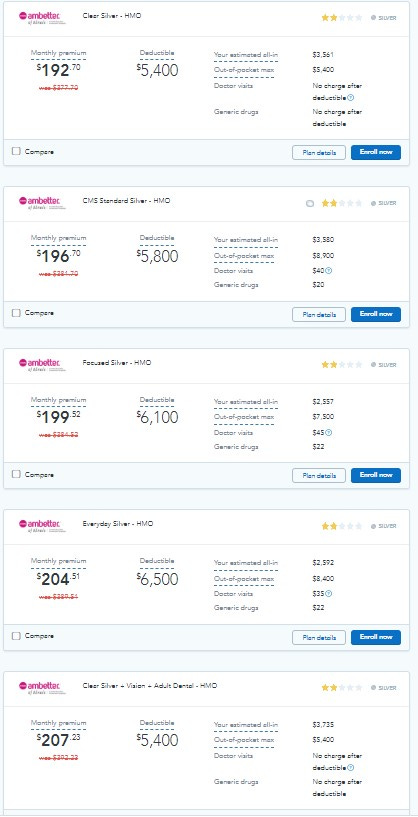Note to subscribers: My apologies for double-subscribing you for some weeks while I tested the Substack platform. Substack is working well -- it does seem to be pulling in new (free) subscribers -- and I think it's time to cut the cord here. I will continue to cross-post on this site but will end the follow.it subscription (though I do appreciate its quality free service, which stepped in the breach when Google discontinued RSS). I hope you will subscribe on Substack (the subscription will remain free) if you're not already subscribed. If you like visiting this site on your own, posts here will continue. Thanks for continuing to read, wherever.
For several years, I was fond of affirming that “surprise” bills — bills sent to insured patients by out-of-network providers working at in-network facilities — were the one systemic healthcare abuse so egregious that even Americans would not tolerate it forever.
This time two years ago, after several false starts, Congress stepped up and managed to include the No Surprises Act (NSA) in a spending omnibus. The bill did ban most surprise billing for emergency care and for scheduled procedures at in-network facilities. The law went into effect on January 1, 2022.
The one major loophole was ground ambulances. 911 ambulance dispatch is still pot-luck: an out-of-network (OON) service may arrive, and may bill you for more than your insurer is willing to pay. But emergency care — and essential “post-stabilization care” — is covered, whether the hospital is in-network or not, or whether the providers who treat the patient are in-network or not. In scheduled procedures at an in-network facility, ancillary providers in a scheduled procedure — the anesthesiologist, the pathologist, the assistant surgeon — cannot surprise-bill the patient. Air ambulances — among the most frequent and expensive balance billers — are covered by the law.
Pre-NSA, surprise billing in the U.S. was prevalent enough to potentially undermine virtually any commercial insurance. According to Kaiser Family Foundation estimates, for people in large employer plans, 18% of all emergency visits and 16% of in-network hospital stays had at least one out-of-network charge associated with the care in 2017. In some facilities and regions, percentages were far higher; in some emergency departments, virtually every provider was OON. Whole business models, including in national private equity-owned ER practices, were based in large part on billing patients at up to 11 times Medicare rates. The major private equity players blocked passage of national balance billing protection at least once.
As the NSA approaches its first birthday, I wondered how the new protections are working. Short answer: there’s not yet much data. CMS has established a national hotline and online form to handle patient complaints but has not yet published any analysis of data collected through the complaint line.
There is some evidence, though, of “surprises” that didn’t happen. A joint survey* of insurers by America’s Health Insurance Plans (AHIP) and the Blue Cross Blue Shield Association released this past November found that more than 9 million claims from providers were subject to the protections of the law — that is, could have triggered balance bills to patients, though presumably not all OON providers in all cases would have sent such bills. The AHIP release notes that each service or procedure was counted as a separate claim, and that a single visit might result in multiple claims (but also in multiple balance bills).
Early impressions
Karen Pollitz, director of the Kaiser Family Foundation’s Program on Patient and Consumer Protections, pointed out to me that oversight of the NSA is largely reliant on complaints. Pollitz said she had heard second-hand that initially, a lot of the complaints that CMS fielded through the national hotline were about billing problems not covered by the law (and lord knows there are many, such as hospitals relentlessly suing patients, garnishing wages and putting liens on houses in pursuit of unpaid bills). That is, callers knew that there was a new law that provided some protection against onerous medical bills, but were unclear as to what those protections entailed. In more recent months, Pollitz has heard, calls have been more on point.
She added, “I gather that most complaints have been referred to other agencies in cases where CMS doesn’t have direct enforcement authority. Complaints are referred to the Department of Labor if the problem is with an employer-sponsored health plan, or to states if the problem is with a provider and the state has stepped up and said it will handle enforcement of providers.” (States can undertake provider enforcement, share it with CMS, or cede it entirely to CMS. On the insurer side, DOL has oversight over self-funded health plans, which insure the majority of people with employer-sponsored insurance.)
Patricia Kelmar, senior director of health care campaigns for the Public Interest Research Group, noted that in just the first nine months of the law, 9 million surprise bills have been prevented. “That's great news to millions of families that don't have to pay a balance bill that they couldn't avoid. That's a lot of money that stays in patients pockets - at their most vulnerable time dealing with a health issue.” More broadly, “It’s always hard to measure something that didn’t happen” (as Pollitz also pointed out). Kelmar said, however, that TV reporters who used to regularly spotlight surprise bills are a good informal source, and one such reporter told her that “calls have totally dropped off.”
Kelmar said that there’s a long way to go in generating public awareness of the new protections. “Do people know they have these protections? If they do get an illegal bill, will they know where to get help? It’s a huge challenge, as medical bills are very complex. Consumers don’t want to open them because, first, they’re usually bad news, and second, they’re hard to understand. We need a clearer billing system in which consumers aren’t afraid to open their medical bills. And we need to be very clear that certain entities shouldn’t be sending bills.”
She added that “CMS is only just beginning its public education campaign. We all have a long way to go to really help consumers.” On that front, Pollitz said that a KFF survey conducted last spring found that three quarters of the public hadn’t heard of the No Surprises Act or knew very little about it.
Kelmar looks to insurers to help increase awareness. She suggests that the insurer’s Explanation of Benefits (EOB) should spell out: “We’ve received these claims from the hospital, applied your insurance, and this is what you owe. Don’t pay more than this.”
I asked why insurers would want to do this. Kelmar said the incentive is strong: “If insurers help patients to identify a surprise bill, they can say ‘Don’t blame us.’ People generally don’t like their insurers, but they can turn that around by helping them avoid surprise bills.” She added that the law helps create a system in which more providers will come in-network.
Most states have Consumer Assistance Programs (CAPs), initially funded with federal grants established by the Affordable Care Act, that field consumer complaints about medical billing. In New York, the CAP hotline is run by nonprofit Community Service Society. Elisabeth Benjamin, VP of health initiatives at CSS, told me that because of awareness generated by the No Surprises Act, “We’ve seen an increase in the number of surprise billing calls. There’s more general awareness around medical debt and billing practices. Also, higher and higher levels of cost-sharing.” Anecdotally, Benjamin said she’d heard that the insurance division of New York’s Department of Financial Services was also getting more calls than pre-NSA about medical billing.
The NSA in action
Health Law Advocates, a nonprofit, provides legal assistance to Massachusetts residents who have problems accessing healthcare or health insurance, or problems with medical bills. While Massachusetts has a balance-billing protection law that predates the ACA, Wells Wilkinson, a senior staff attorney at HLA, says that the NSA has helped in some circumstances where Massachusetts law doesn’t reach.
Wilkinson described one case in which a Massachusetts resident was injured while out of state and treated in a hospital emergency room. He was confronted with two kinds of bills: “One set where the health plan completely denied coverage and he was billed for 100% of charges, and another in which the plan made a payment, and the provider balance-billed for the entire remaining billed cost.”
The layered bills — the patient received four EOBs from his insurer — arose from layered treatment. Initially, the patient went to the ER and was given some scans, but sent home (to a vacation condo) because this was during the pandemic and the hospital did not have an orthopedist on staff. The hospital said they would call after the orthopedist looked at the scans. Next morning, they called and —importantly for insurance purposes — told the patient “you’re not safe to travel” and that he should come in for treatment. The patient then underwent surgery in that hospital. The ‘not safe to travel’ determination was important because under the NSA, OON protections apply as long as ER treatment is necessary to stabilize the patient. If the patient can safely be transported to an in-network facility after stabilization, the protections no longer apply from that point on.
While the reason for the insurer’s 100% denial of what was clearly an emergency service remains inscrutable, Wilkinson says, “We were able to work with the health plan and get all costs eliminated except for small amounts of cost sharing. We also worked with the providers to notify them that they’re not allowed to balance bill for these types of emergency services.” Armed with legal assistance, this patient achieved an independent resolution without recourse to a filed complaint.
That choice underscores a dilemma, however, according to Wilkinson: “Get help from a regulator or try an appeal to the insurer first? One danger in reaching out for assistance: you might miss the insurer’s appeal deadline.”
Gaps and complications
Everyone I spoke to highlighted gaps** in the NSA’s protections — though with an implicit understanding that U.S. healthcare law and billing practices are byzantine and that the law takes a major bite out of patient exposures.
Benjamin at CSS noted that one common complaint that escapes the law’s protections is spurred by a doctor’s office erroneously telling the patient they’re in-network. Often this is a matter of imprecision — “The patient is told ‘we take Blue Cross,' but in fact the office doesn’t take the patient’s particular plan.”
More generally, imprecision with regard to network inclusion is a perpetual and multi-front problem. The PIRG consumer guide to NSA protections warns:
Ask: “Are you part of my plan’s network?”
Do not ask: “Do you take my insurance?”
Sometimes a provider says it will “take” your insurance but it is not in your insurance plan’s network. What the provider means is that it will send the bill to your insurance plan for you but will still charge you an out-of-network rate.
Pollitz at KFF worries about the allowances for OON billing for scheduled procedures, noting that those procedures may be diagnosed while a patient is in the hospital, under circumstances in which it’s difficult to refuse care or seek to ensure that care comes from in-network providers.
“The law says that you can be asked by an OON provider to waive your rights up to 72 hours in advance of scheduling a service. Or, if a service is scheduled less than 72 hours in advance, you have to be given notice — a paper to sign away your rights — no less than three hours in advance.”
“So let’s say you’re in the hospital and the attending doctor decides that morning that you should have an endoscopy — and by the way, the doctor performing the endoscopy is out-of-network.” Should you sign off? How many people will ask for an in-network endoscopist?
Financial pathologies with pathologists
Aside from failure to cover ground ambulances, perhaps the NSA’s largest gap is between the doctor’s office and the lab. While a patient is protected from surprise bills if a healthcare facility —e.g., a hospital, satellite emergency department, or ambulatory care facility — sends blood samples or other test data to an OON provider, there is no such protection if a doctor’s office does so.
I spoke to a cancer patient whose oncologist recently sent her blood sample out for genomic testing without her knowledge. She received an EOB stating that the genomic testing lab was OON and that she would be responsible for the full $5,800 charge. She has not yet been billed. The lab has since asked her permission to file an appeal to her insurer.
Prior to NSA passage, the patient underwent a bone marrow biopsy that was also processed by an OON provider. Her doctor said that the lab in question was the only one he knew of that performed that kind of test at all.
* * *
The NSA should cut the heart out of balance billing practices that not that long ago were endemic in the United States. Most of those who benefit from the law may never know it, as is often the case with good legislation. In early days at least, those who might benefit from it when its provisions are violated may not know to avail themselves of its protections. Over time, the steep fines that attach to violations — $10,000 per episode — should make compliance a norm. We might hope too that in coming years, gaps in the NSA’s protections will be filled.
Americans remain exposed to out-of-pocket healthcare costs that are almost inconceivable in other wealthy countries. But via the NSA, one major and sometimes all-but-unlimited source of financial exposure should be reduced to a shadow of its former self.
- - - - -
* The AHIP/BCBS survey also found that OON bills have submitted for arbitration are far in excess of the level predicted by federal agencies: 90,000 disputes were initiated bay September 30, whereas 17,000 had been predicted for the full year. Given the political clout of hospitals and physician groups, the bill was surprisingly tough on providers in its ground rules for arbitration that OON providers can initiate when they consider the payment offered by the patient’s insurer inadequate. The law emphasizes the “median contracted rate” — the average paid by insurers for the procedure in question in the region in question — as a factor for arbitrators to consider. Lawmakers apparently took to heart studies showing that arbitration rules established by states such as New York and New Jersey that gave more weight to the rates OON providers billed defenseless patients — their “usual and customary charges” led to arbitration awards of payment average about ten times Medicare payment rates. Federal rulemaking centered the median contracted rate more more aggressively, making it a benchmark to be set aside only when other factors offer a compelling case to set it aside. Providers have waged multiple court challenges, and in February 2022, in Texas Medical Association v. U.S. Department of Health and Human Services, et al., a Texas court struck down the rule’s presumptive reliance on the median contracted rate. An amended final rule issued this summer does not privilege the median contracted rate to the same extent as the prior iteration, but retains it as a default standard unless the physician submits factors the median contracted rate does not account for. More court challenges from providers’ groups are in the offing. While the outcomes may have a major effect on healthcare pricing, in this post I wanted to focus on the law’s effect on consumers.
** Last year, I flagged another potential problem with the NSA’s OON protections: In a tiered network, at what level is an OON facility covered?
Photo by A Koolshooter



























